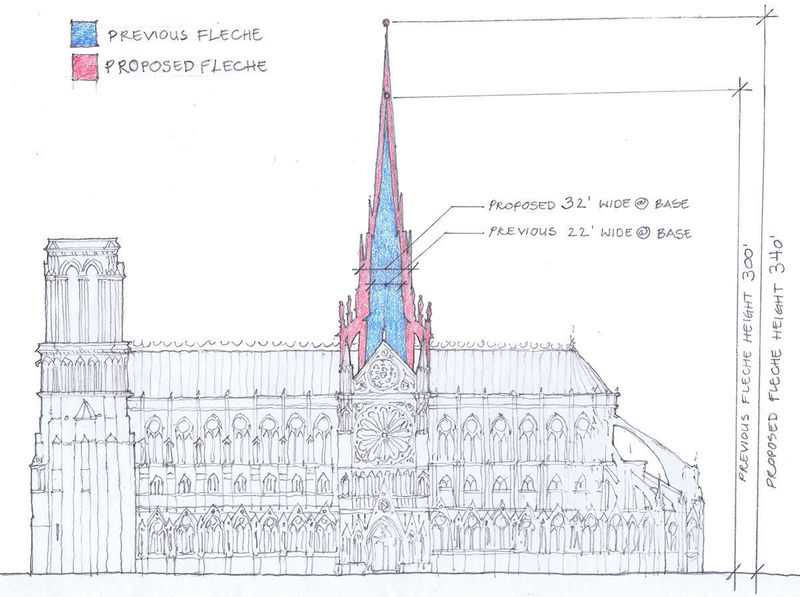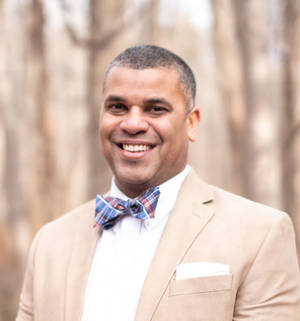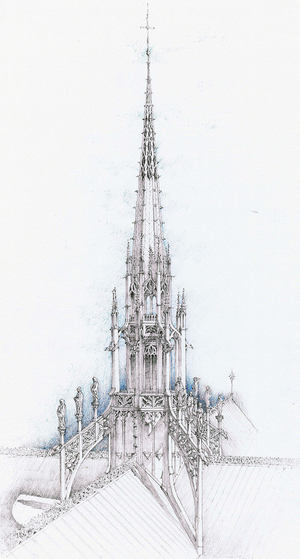 A comparison between C.J. Howard’s proposed flèche (in red) for a restored Notre-Dame and the previous spire (in blue) destroyed in last April’s fire. (Images courtesy of C.J. Howard)
A comparison between C.J. Howard’s proposed flèche (in red) for a restored Notre-Dame and the previous spire (in blue) destroyed in last April’s fire. (Images courtesy of C.J. Howard)
C.J. Howard is an assistant professor of classical traditional architecture and urbanism at Catholic University with an extensive portfolio of ecclesiastical projects as a practicing architect. Here he discusses the future of Notre-Dame cathedral in Paris in the wake of the devastating fire last April:
What is the current status of the restoration of Notre-Dame?

Currently efforts are still focused on material removal and stabilization. Just as there was thorough documentation of the cathedral before the fire, there is now new digital scanned information of the post-fire state. This is now being used as 3-D modelling to help with material removal, but also as a means to keep inventory.
The remediation and stabilization have involved putting up netting to catch any falling debris, the erection of a temporary roof, the use of wood framing to structurally shore up areas such as the ceiling vaulting and columns/piers. In addition to structural remediations, air pollution tests have been taken to help ensure the atmosphere does not include high levels of lead pollution due to the melting of the lead roof. Scaffolding from the ongoing restoration work also creates a physically complex challenge in its removal. Overseeing all of this sensitive work is the architect and chief at Notre-Dame.
A new team will take over at some point as stipulated in a law adopted in July 2019. No definitive resolution has been reached with regard to whether the cathedral should be rebuilt exactly as it was or to use the opportunity to propose modern interventions within the restoration.
You have written about Notre-Dame as “The Throne of Paris.” What architectural features most distinguish the cathedral and fulfill its sacred purpose?
Before talking about what makes Notre-Dame cathedral distinguished, it’s worth generally setting a definition for the sacred purpose of a cathedral. In short, I would propose that the sacred purpose of a gothic cathedral is to help souls get to heaven through the deployment of gothic design to achieve beauty. From that point it is easier to focus in on an answer to the question of how each French gothic cathedral achieves that goal in their own unique and particular way. Notre-Dame as the cathedral of Paris has several things to offer towards its own heavenly end.
The features that primarily distinguish Notre-Dame cathedral are those that one would first experience from the outside. Notre-Dame cathedral, as compared to other cathedrals, has a unique, perhaps intentional, throne-like quality, in that it sits firmly planted on the Ile de la Cité, with a regal posture of unapologetic gravitas and order, not unlike that of the great Sphinx of Giza in Egypt. Its presence in form is robust and its façade noble with a countenance of serene confidence projected through the sober harmony of geometric proportions. This can be seen in a projected nine-square arrangement of the facade with buttress piers and niched bands as vertical and horizontal stitching agents respectively. At the center of this grid sits the pure circle of the rose window. The bottom six squares form an overall square “base,” on top of which the bell towers can finally stand free.
What might explain the particularly robust nature of the cathedral is the influence of the earlier more monolithic Romanesque language that can be seen to some extent throughout the cathedral. One can even imagine a correlation to the fortress-like westworks of Medieval Romanesque churches that then reach back in alluding to ancient Roman triumphal arches. Overall, it is a calculated façade that seems subdued, especially when compared to its more expressive or sublime peers in Laon, Amiens, Chartres and Reims, but its stoic resolve seems almost prescient to the trials and tribulations it would need to face. The success and beauty of this unique facade can be attributed to the element of consonance, which refers to order and proportion, as one of the three elements of beauty proposed by Thomas Aquinas, a medieval intellect who understood that beauty is more profound than aesthetic taste.
Integritas, another of the Aquinas triad for beauty, can be seen in smaller scale on the exterior of the cathedral. Within that robust framework of the façade, rewarding scrutiny, is an application of human-scaled, exquisitely carved sacred sculptural iconography. This layer of refinement participates in the order of the structure while adding a narrative content that helps to inform and enrich the sacred experience. The iconographic program begins at the lower level with the carved figures around the “triumphal” entry portals making visible and legible the themes of Saint Mary and the Last Judgment. Further up, an embedded band of Old Testament figures, then the tracery of the rose window level, then a more substantive yet delicate band of trefoil arches that attempt to boost the bell towers, while providing a diaphanous screen. In between the screen and above it, an element that is both object and ornament, is revealed in the flèche. As the tallest and arguably the most distinguished of features, it is the clearest indicator of the cathedrals ultimate purpose, in pointing to heaven as if to suggest “this is where we want to go.”
All of these characteristics, when added to other parts of the whole, serve to provide a distinct place that nourishes the mind through exquisitely carved iconography and detail, elevates prayer in setting a resonating tone through harmony, and reveres the liturgy and sacraments through the transcendent qualities of exceptional beauty.
When addressing damage to an iconic building like Notre-Dame, should an exact recreation of the previous structure be the primary objective? What place, if any, do contemporary design elements have in a reconstruction project like this?
I have recently made a crude analogy of Notre-Dame to a gecko. Geckos, as a safety mechanism, are able to detach their tails in order to evade predators. Once dispensed, after some time the tail grows back. In a scenario where a gecko loses its tail, one could imagine a series of hypothetical conclusions in answering the question, “What is the proper solution to the lack of tail?”
A – The gecko should not go on living due to the absence of the tail.
B – The gecko could go on living without the tail, being incomplete.
C – The gecko could grow back its tail and be complete.
D – The gecko could have a tail from another animal replace the gecko tail (use your imagination).
Given each scenario, one is probably compelled to answer C. This is reasonable as A is unnecessary, B is insufficient, and D is alien and possibly very weird. If you haven’t guessed it, the tail in this analogy is the flèche, as the most prominent element of the cathedral that was lost in the fire.
So, for me the question is, why not recreate Notre-Dame as it was? It has lost something essential to its makeup and would like it back to better fulfill its purpose. Today, the cathedral’s purpose is as it was in the beginning, to be a prominent church designed to help the people of Paris get to heaven, through beauty, as achieved by gothic principles. Beyond that, it has taken on additional purposes of being an exemplary work of architectural and cultural heritage able to transmit meaningful lessons for us to learn from. It also has taken on the status of an icon. For all of these purposes the cathedral needs to be complete again.
Contemporary design elements could have a place in the reconstruction of Notre-Dame, but only to the extent that they continue to contribute to the gothic beauty of the cathedral. Wholeness and harmony through the gothic language are necessary to create a resonance between each part of the cathedral to create a larger harmonic whole. It is conceivable that a new truly innovative contemporary gothic architecture can achieve this, but that is a hypothetical at this point.
How do modern construction techniques and materials influence what can and should be done?
The rightful concern for a piece of architectural heritage is that we might lose it, and in so doing would lose its value as a transmitter of knowledge, wisdom and culture. Notre-Dame’s value as a building is comprehensive from façade material to visible structure to hidden structure. The lessons abound and are valuable because they have succeeded across the board at what they do. A testament to that is the durability/sustainability of the cathedral over many years, in many cases despite circumstance. So, when considering the potential influence or inclusion of modern construction techniques and materials in the presumed rebuilding of Notre-Dame, there should be careful consideration about the implementation, as the burden is on them to meet the high standards of the existing techniques, some of which were innovative and modern in their own time.
The credential of merit is crucial here. The modern construction industry is far afield from and unfamiliar with the traditional construction of Notre-Dame and therefore may require a shifting of expectation and understanding. That being said, today, there is an amazing adeptness to push the capabilities and boundaries of technology. So if an opportunity arises to truly improve the success of the cathedral’s performance in shoring up any weaknesses, then these means should not be dismissed out of hand. They should however be deferential to the purpose of the building as a teacher and as a mentor.
In your piece, you write that “the powers-that-be should consider the conservation of the cathedral’s inherent beauty as the top priority.” Given the different visions that architects have proffered in proposed designs, what standard of beauty should be applied?
The standard of beauty that should be applied to any aspect of the cathedral is the standard that best serves its purpose. That purpose being to get the souls of Paris to heaven through beauty achieved by the principles of Opus Francigenum or gothic architecture. This standard of beauty is best and most appropriately articulated by Thomas Aquinas. It is also something that is evident and knowable or objectively true, that aims to be as perfect as it can be. The means, according to Aquinas, to achieve this are captured by the inclusion of three elements:
Wholeness (Integritas) – The nature of the cathedral is perfected by having all of the elements of a cathedral. This would include what one expects to find in a church to function liturgically with the addition of a cathedra, but also it includes the iconographic content and the craft of the sculpted stone to enrich that reading.
Proportion (Consonance) – The cathedral models the cosmos by using perfect geometric proportion, to create harmony and unity, thereby emulating God as divine architect. The cathedral also answers the call to have decorum appropriate for a cathedral in its dress and architectural prominence.
Clarity (Claritas) – The cathedral would not be the cathedral if you could not perceive its majestic wholeness and proportion. Within the heights of the vaulted stonework, the cathedral reveals cathedralness through the luminosity provided by the jewelled effect of the stained glass windows (Lux Nova) allowing the perception of beauty.
Abbot Suger manifested this idea in his creating gothic architecture to reveal evident splendor to transcend the mundane through geometry, proportion, unity, craft, iconographic content and ethereal light. Notre-Dame is one of the earliest great works of gothic architecture and owes its beauty to the attempt of making it as perfect as it can be as a complete work of gothic sacred architecture. This is not to say that beauty can’t be offered in other ways, but that ultimately for this church, it is necessary to understand the value of beauty through the standard proposed by Thomas Aquinas and the medieval interpretation.

You offered your own design proposal for a new flèche, or spire. If not an exact restoration, you write, a design in the gothic tradition “that dares to exceed what was once there” would be another alternative. How does your flèche reflect Notre-Dame as the world knew it and what differences does it introduce?
The flèche design I proposed intends to build on what was there in language and in specific character. The language is obviously gothic and as such contains a vocabulary of similar elements and motifs that are known within the lexicon of gothic articulation. This allows for a visual congruency as part of a larger whole of the cathedral. The proposal also, on a very basic level, takes the form of a French flèche, as a light arrowlike accent located at the crossing, but not a substantial architectural continuation of the crossing. This is in contrast to the crossing tower that one could find in England as a more robust compositional element coming directly up from the crossing walls below.
Where the flèche departs from the previous design in an attempt to “improve” on it, is also with respect to gothic language and the form of the flèche. The development of successive proposals of gothic architecture often adopted a spirit of competition to make things higher, more ornate, lighter and ultimately more transcendent. I took this same spirit of oneupsmanship and employed the later development of “flamboyant” gothic architecture. I attempted to lift, lighten and take specific tracery motifs common to that developed language. All of this was done while maintaining the same essential parts of the previous flèche, but with a deliberate attempt to have it appear larger and taller to better draw attention, or souls, to the cathedral.
What I have proposed is essentially a gothic revival flèche, in order to put something forward that could claim that it is “authentic,” being developed before the end of medieval times, “newer,” as a developed trajectory and therefore suggest that it is better. So, while being different it is not necessarily new, though it is also not entirely contrived because one could have imagined Viollet-le-Duc, who restored Notre-Dame in the 19th century, proposing this as well.
In order to present something truly different, which seems to be the excitement of possibility for our time, to be a part of the conversation of Notre-Dame over the ages, we would have to imagine, not an incarnation of Viollet-le-Duc, but that of a divinely inspired Abbot Suger. Until that happens, we are best served by learning and appreciating the benefits that a restored Notre-Dame would offer.
Interview by Jason Kelly ’95, an associate editor of this magazine.